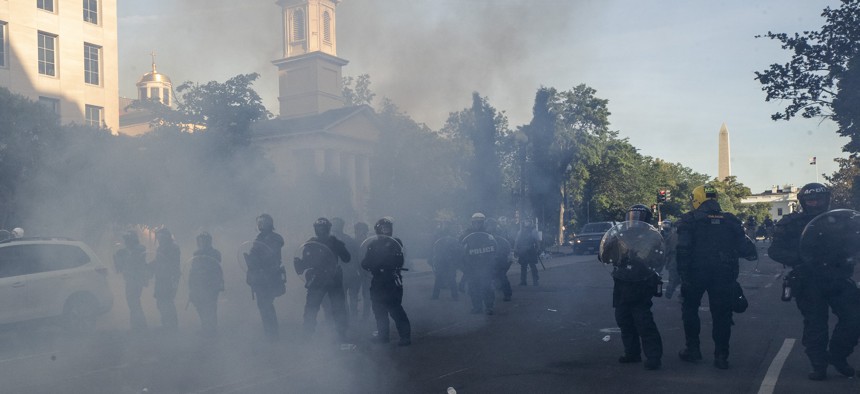
In this June 1, 2020 file photo police move demonstrators away from St. John's Church across Lafayette Park from the White House, as they gather to protest the death of George Floyd in Washington. AP Photo/Alex Brandon
National Guard Commander To Testify ‘Excessive Force’ Used on White House Protesters
Officer on the scene saw spent tear gas canisters, contradicting key details of Attorney General Barr’s account of the controversial night.
A National Guard commander who was present during the forcible clearing of protesters in front of the White House last month accused the Trump administration of an “unprovoked escalation and excessive use of force” on peaceful protesters, and contradicted key elements of Attorney General Bill Barr’s account — including whether tear gas was used in the incident.
In a prepared statement to be delivered to a House committee on Tuesday, Maj. Adam DeMarco said that protesters gathered in Lafayette Park were “behaving peacefully, exercising their First Amendment rights” when Park Police abruptly moved in to clear the area so that President Donald Trump could walk through to take a photograph at a nearby church, approximately 30 minutes before a 7 p.m. city curfew. Although the Park Police issued three warnings over a megaphone, DeMarco said — warnings required both by law and court rulings — “the announcements were barely audible and I saw no indication that the demonstrators were cognizant of the warnings to disperse.”
DeMarco also accused a Park Police liaison officer of misleading him about the use of tear gas. On June 1, DeMarco was on the scene serving as the liaison between the D.C. National Guard and D.C. Health, the city government’s department for health, and local hospitals, “to facilitate immediate needs requests, surge capacity planning, and emergency events associated with the pandemic.” He said that when he asked his Park Police liaison if tear gas was being used on protesters, the liaison officer claimed that explosions DeMarco could see from the clearing operation were “stage smoke,” not tear gas.
“But I could feel irritation in my eyes and nose, and based on my previous exposure to tear gas in my training at West Point and later in my Army training, I recognized that irritation as effects consistent with CS or ‘tear gas,’” DeMarco said. “And later that evening, I found spent tear gas cannisters [sic] on the street nearby.”
Barr, defending the operation in a press conference on June 4, claimed that protesters in the park were growing "increasingly unruly” and “refused” to disperse after receiving three warnings. He has claimed that the maneuver was an appropriate use of force needed to create “more of a buffer” around the White House complex, denying that it was a last-minute change to create a photo opportunity for the president. He has defended police tactics, insisting that “there was no gas” and “pepper spray is not a chemical irritant.”
The Trump administration’s use of force at that event, and its handling of the protests in Washington, D.C. broadly, have faced widespread condemnation, including from four prominent retired generals. Trump’s first defense secretary, Jim Mattis, former Joint Chiefs chairmen Mike Mullen and Martin Dempsey, and retired top Afghanistan war commander John Allen all issued public missives condemning the militarized response to the protests and unrest, and specifically decried the park operation.
DeMarco will appear alongside Gregory Monahan, the acting chief of the Park Police, at 10 a.m. on Monday, Aug. 3, in front of the House Natural Resources Committee, which has jurisdiction over the Park Police.
According to DeMarco, he was briefed at approximately 5:30 p.m. that the park was to be cleared in order to install a larger security barricade on H street, pushing the protesters farther away from the White House. Because D.C. Mayor Muriel Bowser’s curfew was not until 7 p.m., DeMarco said he was not expecting any movement before then. DeMarco said he also asked prior to the operation whether tear gas would be used, having noticed canisters strapped to Park Police officers’ vests. The Park Police liaison said the chemical irritant would not be employed, DeMarco said.
At 6:05 p.m., DeMarco reported, Barr appeared and conferred with Park Police officers. Joint Chiefs Chairman Gen. Mark Milley — who has been criticized for his presence during the operation — also arrived and spoke with DeMarco. “General Milley told me to ensure that National Guard personnel remained calm, adding that we were there to respect the demonstrators’ First Amendment rights,” DeMarco said.
Milley has denied any prior knowledge of the clearing operation and later said he was wrong for appearing at the protests in fatigues, which critics have said crossed an important line between civilian law enforcement and the military. “I should not have been there,” he said, in a speech ten days later.
The first of three warnings were given at 6:20 p.m., according to DeMarco, and the clearing operation began shortly thereafter. “No National Guard personnel participated in the push or engaged in any other use of force against the demonstrators,” DeMarco said, backing up official statements from the Pentagon. From the northeast corner of the square, DeMarco said he witnessed “people fall to the ground as some Civil Disturbance Unit members” of the D.C. police “used their shields offensively as weapons.”
At around 7:05 p.m., DeMarco said he saw Trump walk towards St. John’s Church, where he would be photographed holding up a Bible. His arrival came as a “complete surprise,” DeMarco said, because “we had not been briefed that he would enter our sector.”
Don't miss:
“As for the new security barrier, whose installation was the stated purpose of the clearing operation, the materials to erect it did not arrive on the scene until around 9:00 pm, and it was not completed until later that night,” DeMarco said.
DeMarco in his testimony condemned the operation as an unnecessary use of force that was “deeply disturbing to me, and to fellow National Guardsmen.”
“Having served in a combat zone, and understanding how to assess threat environments, at no time did I feel threatened by the protestors or assess them to be violent,” he said. “From my observation, those demonstrators — our fellow American citizens — were engaged in the peaceful expression of their First Amendment rights. Yet they were subjected to an unprovoked escalation and excessive use of force.”




